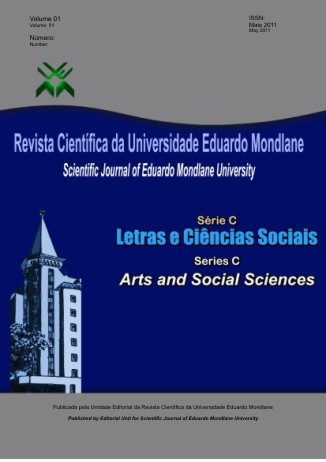MORPHOSYNTACTIC ANALYSIS OF THE MORPHEMES -UR- AND -AM- IN CIWUTEE
Abstract
Morphemes are minimal units of morphological analysis. Taking this assumption into account, it is clear that, in order to capture the parametric features of morphological units, it is necessary to explore their larger field (morphology). The focus of the research is on morphemes that can occur before and/or after the base. The research aims to analyse, test, characterise and distinguish the morphemes -ur- and -am-, from a morphosyntactic and lexico-semantic perspective. To this end, the distribution test, the Baker Mirror Principle (1995) and Baker Incorporation (1988) theories were used to assess the existence of some linearity and possible lexico-semantic restrictions in the concatenation of derivational units which, in turn, can establish a relationship with the extralinguistic world. With these theoretical approaches, we intend to assess the real category of morphemes -ur- and -am- that, in some Bantu languages, function as fossilized verbal extensions. The objectives listed refer us to the question “do the morphemes -ur- and -am- behave as verbal extensions and what is the real morphosyntactic and lexico-semantic category of the bases that aggregate them in Ciwutee? The possible answers that arise from the above question are: a) the morphemes -ur- and -am- behave as extensions in Ciwutee; b) the morphemes -ur- and -am- establish distinct morphosyntactic and lexico-semantic restrictions on the bases that aggregate them; and; c) the morphemes -ur- and -am- are fossilized extensions in Ciwutee. Using the qualitative approach, the bibliographic method and Introspection, as well as the distribution test, it was possible to conclude that -ur- is a verbal extension that joins the verbal bases with cyclic movement semantics and -am- is not an extension, but rather a verbalizer that joins only the ideophonic bases. This general conclusion was given by 84.7% of informants from the 100% sample universe.
References
BAKER, M. Incorporation: A Theory of Grammatical Function Changing. Chicago: University of Chicago Press, 1988.
BAUMBACH, E. Analytical Tsonga grammar. Pretoria: University of South Africa (UNISA), 1987.
BYBEE, J. Morphology: A Study of the Relation Between Meaning and Form. Amsterdam: John Benjamins.Cambridge: Cambridge University Press,1985.
CÂMARA, C. Análise Minimalista das Extensões Verbais em Nyungwe. Maputo: CEA, 2018
COCCHI, G. Verbal Extensions in Tshiluba. Língua., v.1, Pp.75-89, 2008.
DOKE, C. A Comparative Study in Shona Phonetics. Johannesburg: The University of the Witwatersrand Press, 1931.
FRIESEN, L. Valence Change and Oroko Verb Morphology (Mbonge Dialect). Dissertation (Masters in Linguistic) – University of South Africa, 2002.
HYMAN, L. Suffix ordering in Bantu: A Morphocentric approach. Rutgers Optimal Archive (ROA), article 2002, 506-0302.
LANGA, D. Morfologia do Verbo em Changana. Maputo: Centro de Estudos Africanos (CEA), 2013.
LANGA, D. Verbal Extensions in Changana: A Re-statement. In Akindele et al. (eds). LASU: Journal of the Linguistics Association of Southern African Development Community [SADC] Universities. v. 3. Linguistics Association of SADC, p. 51-, p. 60, 2007.
LODHI, A. Verbal extensions in Bantu: the case of Swahili and Nyamwezi. Africa & Asia: Göteborg working papers on Asian and African languages and literatures, v.2, p 4-26, 2002.
MATEUS, B., Duarte, I., Faria, I. Gramática da Língua Portuguesa. 2ª Edição. Lisboa: Editora Caminho. Lisboa, 1989.
MARCONI, M e LAKATOS, E. Metodologia de Trabalho Científico. 6a Edição. São Paulo: Editora Atlas, 2021.
NGUNGA, A. Introdução à Linguística Bantu. 2ª Edição. Maputo: Imprensa Universitária, 2014.
NGUNGA, A. Lexical Phonology and Morphology of the Ciyao Verb Stem. Thesis (PhD in Linguistic) – Berkeley, University of California, p 17, 1997.
NGUNGA, A. Restrições na combinação e ordem dos sufixos verbais em Ciyao. Simango, A. (ed.). Folha Linguística, v.3. Maputo: Imprensa Universitária. p. 8-18, 1999.
NHAPOCA, E. Identidade categorial e função dos ideofones do changana. Florianópolis/SC, 2017.
RAZÃO, J. Implicações Sintácticas da co-ocorrência das Extensões Causativa e Passiva em Ciwutee. Dissertação (Mestrado em Linguística) – FLCS, UEM, 2017.
RIBEIRO, A. Gramática Changana (Tsonga). Kusubi: Marianum Press SSPC, 1965.
SITOE, B. (1996). Dicionário Changana - Português. Maputo: Instituto Nacional do Desenvolvimento da Educação (INDE), Ministério da Educação, 1996.
WAWERU, M. Gĩkũyũ Verbal Extensions: A Minimalist Analysis. Unpublished PhD Thesis. Kenyatta University, 2011.
ZEMBA, M. (2015). A Grammatical Sketch of Kunda Language. Dissertation (Masters in Linguistic) – University of Zambia, Lusaka.


